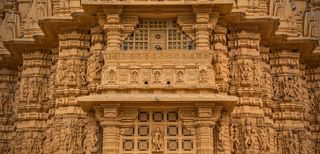Introduction
The highly famed, intricately carved marvel Somnath Temple is believed to be the place where the first of the twelve Jyotirlingas emerged in India. This temples lies at the meeting of Kapila, Hiran and Sarasvati rivers and the waves of the Arabian Sea and flow touching the shore on which it is constructed. This temple is a perennial source of inspiration for millions of Hindus since time immemorial. The Shiva Purana describes Shree Somnath Jyotirlinga as :
सौराष्ट्रदेशे विशदेऽतिरम्ये ज्योतिर्मयं चन्द्रकलावतंसम्।
भक्तिप्रदानाय कृपावतीर्णं तं सोमनाथं शरणं प्रपद्ये॥[ref]
which means , Who to offer his devotion, in the most beautiful and serene Saurashtra region (Kathiawad) mercifully incarnated, the moon is the ornament on whose head, I go under the shelter of Lord Shree Somanatha in the form of Jyotirlingam.
Architectural Facts
The temples in India have always been the epitome of great craftsmanship and architectural marvel and showcases rich culture and heritage. The Somnath temple was constructed in the Chalukya style of architecture, Somnath Temple reflects the expertise of the Sompuras that are master masons of Gujarat. The main spire of the temple is 150 foot high and has a flag post of 27 foot tall. A kalash of weight 10 tons was put on the top of the spire.
The temple’s positioning is quite unique. The temple is positioned in such a way that not even a single piece of land is visible from the Somnath seashore until Antarctica. The Tirsthambh located at the temple indicates that the nearest landmark (South Pole or the Antarctica) is located at about 9936 km away indicating the geographical wisdom of ancient India.

History
Ancient Indian traditions maintain a close relationship of Somnath with release of Chandra (Moon God) from the curse of his father-in-law Daksha Prajapati. Moon was married to Twenty-Seven daughters of Daksha. However, he favoured Rohini and neglected other queens. The aggrieved Daksha cursed Moon and the Moon lost power of light. With the advice of Prajapita Brahma, Moon arrived at the Prabhas Teerth and worshipped Bhagvan Shiva. Pleased with the great penance and devotion of Moon, Bhagvan Shiva blessed him.The Moon God is said to have been relieved from the curse of his father-in-law Daksha Prajapati by the blessings of Bhagvan Somnath. In the Shiva Purana and Nandi Upapurana, Shiva said, "I am always present everywhere but specially in 12 forms and places as the Jyotirlingas". Somnath is one of these 12 holy places. This is the first among the twelve holy Shiva Jyotirlings. Pauranic traditions maintain that Moon had built a golden temple, followed by a silver temple by Ravana, Bhagvan Shree Krishna is believed to have built Somnath temple with Sandalwood.[ref]
The research based on ancient Indian classical texts show that first Somnath Jyotirling Pran-Pratistha was done on the auspicious third day of brighter half of Shravan month during the tenth Treta yug of Vaivswat Manvantar. Swami Shri Gajananand Saraswatiji, Chairman of Shrimad Aadhya Jagadguru Shankaracharya Vedic Shodh Sansthan, Varanasi suggested that the said first temple was built 7,99,25,105 years ago as derived from the traditions of Prabhas Khand of Skand Puran. Thus, this temple is a perennial source of inspiration for millions of Hindus since time immemorial.[ref]
The Somnath Temple is the seventh temple built to commemorate Lord Somnath, who was also known as Bhairaveshwar, Shravanikehswar and Shrilingeshwar, in Sat Yug, Treta Yug and Dwapar Yug respectively. The second version of the temple came into being under the initiative of the Vallabhi king around 408AD-768AD. In 725AD, the old ruler of Sindh took his army and attacked the temple and destroyed it. Again in 815AD Pratishtha King Nag BhattII constructed the temple for third time using red stone.
This temple is often referred to as the ‘eternal shrine’ because historical records say that this temple has been destroyed several times by invaders and have been reconstructed several times too. Archaeological investigations point out that the temple of Somnath had been rebuilt nearly thrice before the raid of Muhammad Ghaznavi in the year 1026. In AD 1026, Mahmud of Ghazni first looted the temple, and then came Afzal Khan, the commander of Ala-ud-din Khilji and later Aurangzeb. It is said that the temple was looted and destroyed as many as seventeen times.
Reconstruction
The Iron man of India, Sardar Vallabhbhai Patel was instrumental in the construction of present temple. The latest rebuilding of Somnath temple was done in 1947 under the initiative of Sardar Vallabhbhai Patel, the then deputy PM. Prabhashankar Sompura was chosen as the architect and thus the present day Somnath temple came into being.In 1951, when India’s first President Dr. Rajendra Prasad proposed to purify Jyotirling, he said, “This temple of Somnath is a symbol of victory over construction on destruction”. The Indian President Dr. Shankar Dayal Sharma dedicated this temple to country on December 1,1995. The temple is built under Shri Somnath Trust and this trust is now monitoring the temple. [ref]
